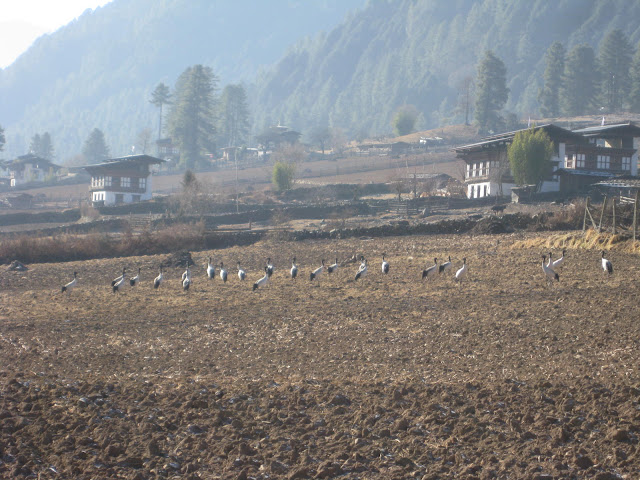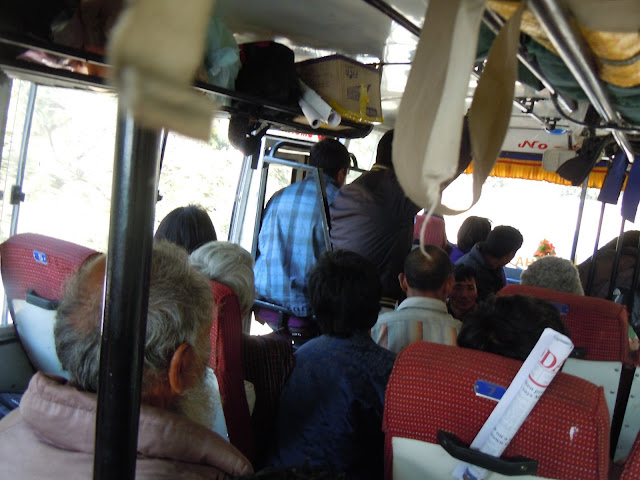 |
| Black Necked Crane at the BNC Museum |
To Phobjikha Valley, Part II: The Black Necked Cranes
The morning sky was the blue of the frescoes inside St. Marks Basilica in Venice; the blue of the gentian that grows in the upper Himalayas. Frost had painted the dry grasses silvery white and the breath of the Ferghana horses grazing at the edge of the marshes encircled their heads in clouds.
We had been awakened by the sound of the Black Necked Cranes calling to one another from across the valley as the sun's first light crested the mountain tops and spilled like melted butter over the spruce, pine and cypress forests ringing the widely scattered village of Phobjikha.
 |
| Brick Root in the Valley |
 |
| Frosty Valley |
 |
| Ferghana Horses (at least I think that's what they are!) |
We had been awakened by the sound of the Black Necked Cranes calling to one another from across the valley as the sun's first light crested the mountain tops and spilled like melted butter over the spruce, pine and cypress forests ringing the widely scattered village of Phobjikha.
Inside Yueli Kiis, our lodging for the night, we were warm and sleepy under several blankets and quilts abetted by hot water bottles at our feet, but the cranes' honking gave us a reason to toss off the covers and brave the cold of the room The fire in our wood stove had burned down to embers during the night, and since we were leaving in search of cranes, we didn't bother to stoke it.
 |
| Yueli Kiis |
Breakfast was impressive, especially considering that Brick, Lucy, and Matt and I were the only guests in the lodge--pancakes, cereal, milk tea and eggs--and the owner had packed Matt and Lucy onion sandwiches for their hike over the mountain to Wangdi where they were hoping to flag a taxi. They had hired a local to guide them; the trails across Bhutan are not marked, and are often barely recognizable as trails and criss-crossed with paths made by herders, villagers and livestock, including the yaks and horses that the Laya people lead down to the valleys to forage during the harsh northern winter. We drank too many cups of tea, keeping Matt and Lucy company as they waited for the guide to meet them, and then we all left, they for the trail and we in search of the flocks of cranes we could still hear from inside the lodge.
A dirt path that doubles as a road weaves across the valley floor, passing a cluster of tsongkhangs and houses and children washing up in the cold morning at the outdoor taps. Brick and I followed the road past the horses and past a cluster of three unusual chortens made only out of cloth (most chortens in Bhutan are stone or mud brick) affixed to poles; we were told this style of chorten originated in this valley with Guru Rinpoche hundreds of years ago. They cast weird shadows in the early morning sun.
The road meandered across the valley and over a rill fed by the marsh where the cranes breed, and then followed the edge of a forest, past a water-powered prayer wheel, a common sight in Bhutan due to all of the waterfalls and streams that have their source at the tops of these mountains. It emerged in the sun on a rise above a large farm that might have grown buckwheat, potatoes, or barley rather than the rice common in the lower, hotter Punakha Valley. There, inside a fenced-in field about 500 yards across the valley, was a flock of perhaps 30 cranes, feeding on the gleanings of last year's crop.
The cranes, one of only fifteen remaining species of cranes in the world, are tremendous in size--they appear to be nearly four feet in height with pale gray bodies and black necks and heads. Known as Thrung Thrungs, or 'heavenly birds' in Bhutan, these birds appear in dances and folklore across Bhutan and Tibet. Globally endangered, they number only about 6000 worldwide; in the Phobjikha Valley, their population has increased from about 250 ten years ago to almost 400 today due to comprehensive protection efforts by the Royal Society for the Protection of Nature (RSPN) in concert with the willing support of the locals who benefit from the tourist trade generated by interest in these beautiful birds.
We retraced our steps along the road and then cut through the fields over terrain that reminded us both of the Alaskan tundra--tufted hillocks of peaty grass and duff--stepping carefully to avoid cow pies and puddles. As we drew close to the flock, we slowed our pace and veered away from the cluster of birds, hoping to take them by surprise by coming around from their flank. Not speaking, taking steps with great care so we wouldn't break sticks or make any sudden moves, we followed the fence's perimeter, heads down, cameras ready. When we were about fifteen feet from the nearest cranes, we very slowly rose to our full heights to take a picture, but the cranes' vigilance brought all their heads around toward us in unison, and in a great, loud honking whirlwind, they all rose into the air as though they were one creature and headed for the other end of the valley. Fortunately, Brick caught them in flight as they rose above us:
 |
| Photos by Brick Root |
We had been told by Matt and Lucy that the Black Necked Crane Museum was worth a visit and that we would be able to watch the birds through telescopes there, so we made our way to the main road and followed it through the village, past our lodge and the shuttered shops (February is the off-season) to the hexagonally shaped museum built into the side of a hill to maximize the scope of the view from the bank of windows that faces the valley. The museum doors were locked, but Matt had told us that an old man who lived at the farm up the hill from the museum had a key and would let us in and focus the telescopes for us. I found him chatting with a few young men on his front steps, and although he spoke not a word of English, he knew what I meant when I asked if anyone had the key to the museum? His teeth and gums were stained red from chewing doma, and the gritty juice ran from the sides of his mouth in a gruesome trickle. His knees were somewhat bowed and his gho was filthy, but he was very happy to help us and patiently waited while Brick and I watched several groups of cranes through the telescopes; Brick counted nearly 100, and we could see only a small part of the valley from the museum windows. We watched a short, informative video made by an ornithologist working with the RSPN and browsed the library of books about birds and other wildlife in Bhutan. After about 45 minutes there, we decided it was time to think about how we were going to get back to Punakha since the only bus heading west had left at 8:30 in the morning.
 |
| Black Necked Crane Museum |
After a lunch of instant noodles and milk tea back at Yueli Kiis, the owner's 15 year old son conjured a ride for us with his cousin, a clever ruse to get himself a free ride to Punakha where his friends from Ugyen Secondary School, a private high school near my public high school, would be waiting to show him a good time. He and his cousin were excellent company on the ride back--a ride that took half as long as the bus, thankfully--answering our questions about Bhutanese history and about the Phobjikha Valley and filling us in on the care and feeding of the typical teenager in Bhutan. They knew about Jimi Hendrix and the Rolling Stones and had playlists on the car radio (which took a thumb drive loaded with music) that represented current American and British pop music.
Brick and I plan to return to the Phobjikha Valley in the summer when it has greened to hike up to the Gangtey Monastery, the center of the Nyingmapa Buddhist tradition in Bhutan. It is the Buddhist belief in reincarnation that underscores the desire to protect the cranes in the first place--after all, according to Buddhism, all the cranes were once our mothers!
Brick and I plan to return to the Phobjikha Valley in the summer when it has greened to hike up to the Gangtey Monastery, the center of the Nyingmapa Buddhist tradition in Bhutan. It is the Buddhist belief in reincarnation that underscores the desire to protect the cranes in the first place--after all, according to Buddhism, all the cranes were once our mothers!
Next Adventure: Gasa Dzongkhag in northwestern Bhutan.


















